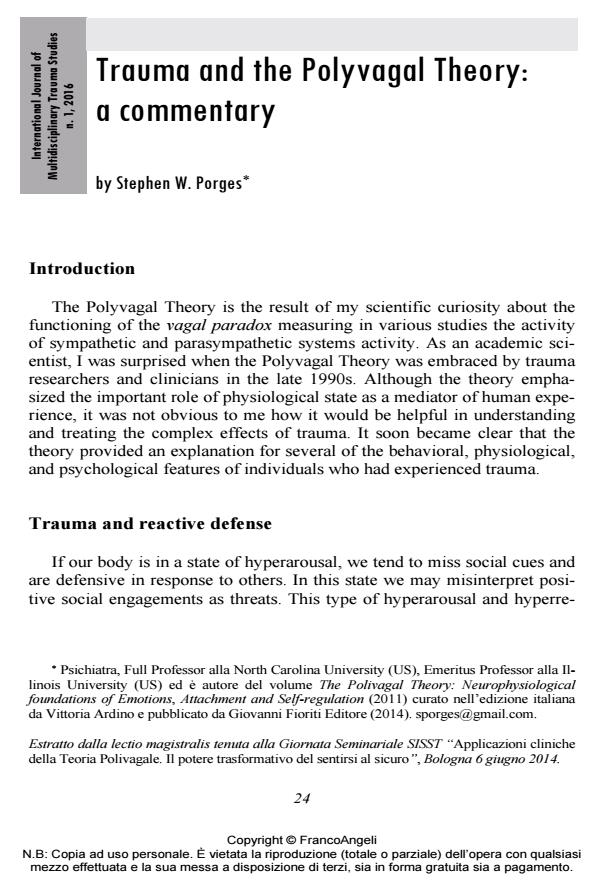Trauma and the Polyvagal Theory: a commentary
Journal title INTERNATIONAL JOURNAL OF MULTIDISCIPLINARY TRAUMA STUDIES
Author/s Stephen W. Porges
Publishing Year 2016 Issue 2016/1
Language English Pages 7 P. 24-30 File size 169 KB
DOI 10.3280/IJM2016-001003
DOI is like a bar code for intellectual property: to have more infomation
click here
Below, you can see the article first page
If you want to buy this article in PDF format, you can do it, following the instructions to buy download credits

FrancoAngeli is member of Publishers International Linking Association, Inc (PILA), a not-for-profit association which run the CrossRef service enabling links to and from online scholarly content.
The Author of the Polyvagal Theory clarifies how social behaviour attenuates defences promoting actions that allow to feel safe. According to this theory, interventions that stimulate the feeling of being safe and the use of social behaviour to adjust physiological states are particularly effective for the treatment of psychological disorders depending on the activation of the inadequate system of defences. Highlights the connections between functions of the peripheral nervous system and behaviour, with particular interest to neurophysiological variables associated with emotions, attachment, social communication, self-regulation, defensive strategies and psychiatric disorders. In this theory, he sustains that the evolution of the peripheral nervous system is connected with affective experience, expression of emotions, voice communication and consequent social behaviour.
Keywords: Trauma, polyvagal theory, dissociation, self-regulation.
- Healing While Studying Mary O’Rawe, pp.179 (ISBN:979-8-88730-500-4)
- How is a psychotherapeutic process like a psychedelic drug? Neurocognitive evidence for a novel mechanism of action with Regenerating Images in Memory Paul F. Cook, Laurra M. Aagaard, Lisa Krug Avery, Nichole Long, Allen Alford, Deborah Sandella, in Frontiers in Psychology 1539079/2025
DOI: 10.3389/fpsyg.2025.1539079 - Frozen in trauma, anchored in survival: A study of dissociative states in post-sexual assault survivors Rajat Mitra, Pankaj Singh, Nidhi Mitra, in European Journal of Trauma & Dissociation 100612/2025 pp.100612
DOI: 10.1016/j.ejtd.2025.100612
Stephen W. Porges, Trauma and the Polyvagal Theory: a commentary in "INTERNATIONAL JOURNAL OF MULTIDISCIPLINARY TRAUMA STUDIES" 1/2016, pp 24-30, DOI: 10.3280/IJM2016-001003